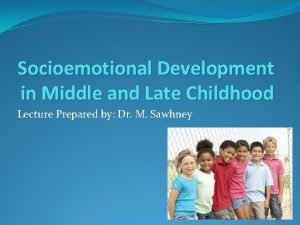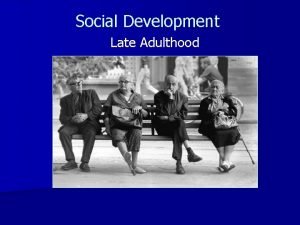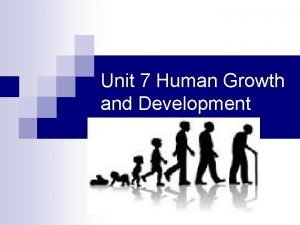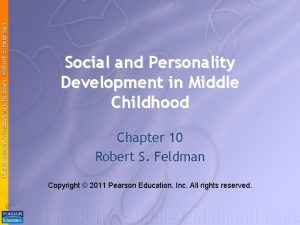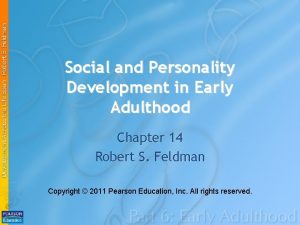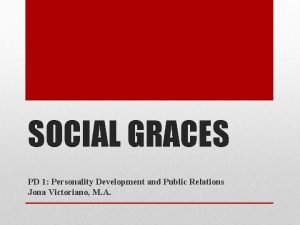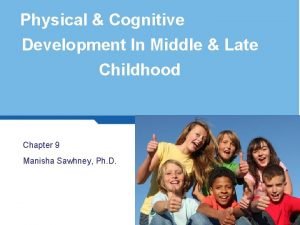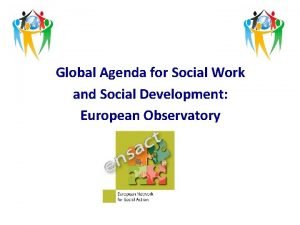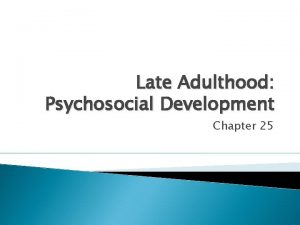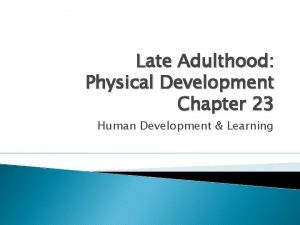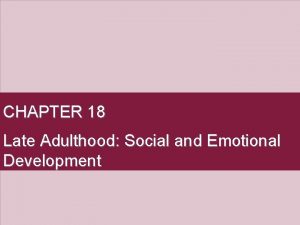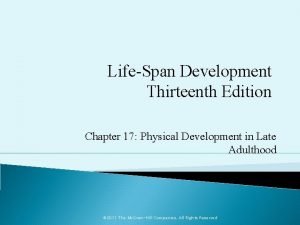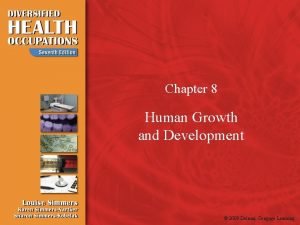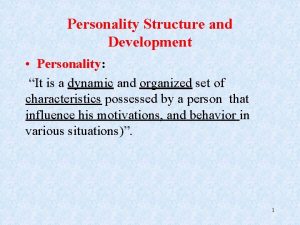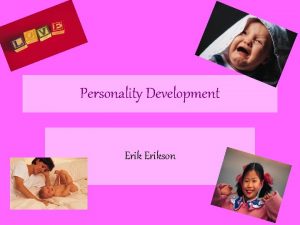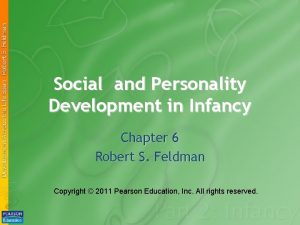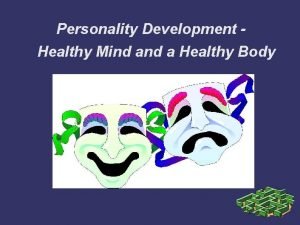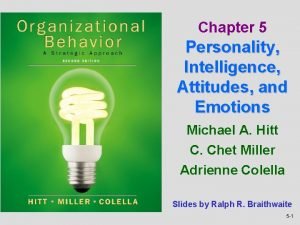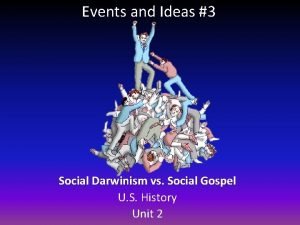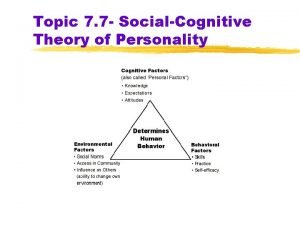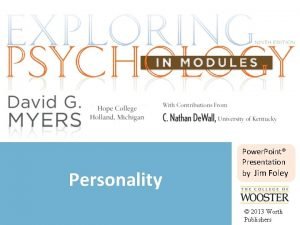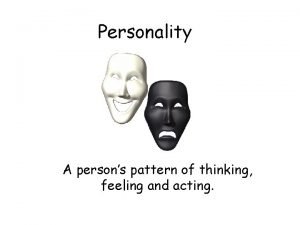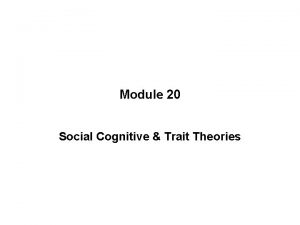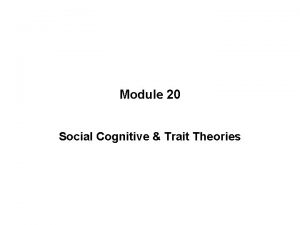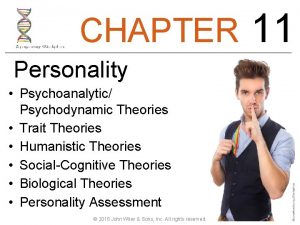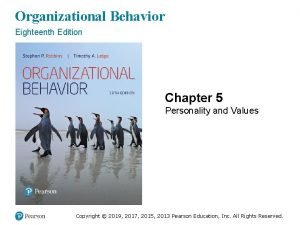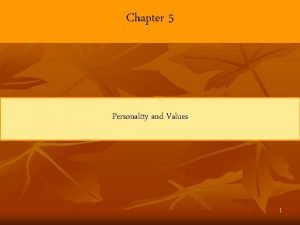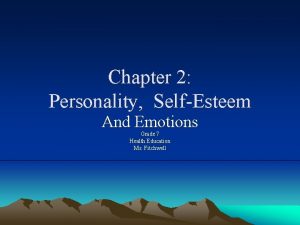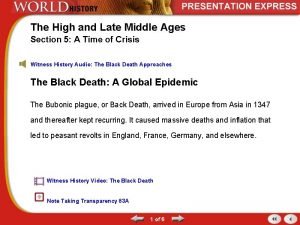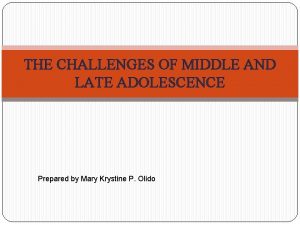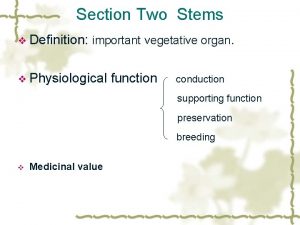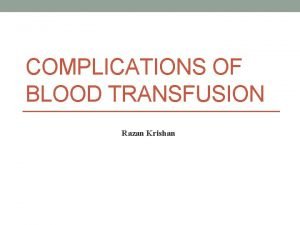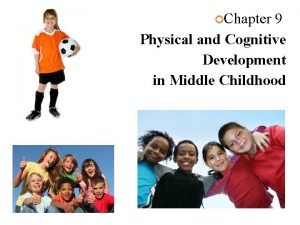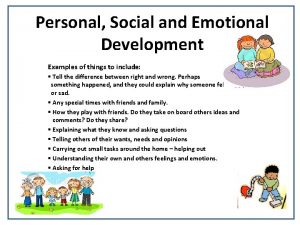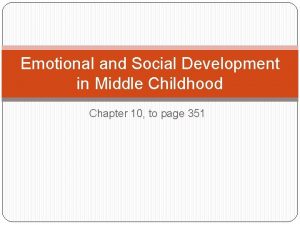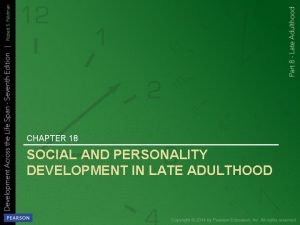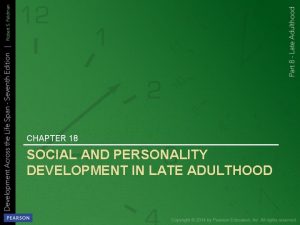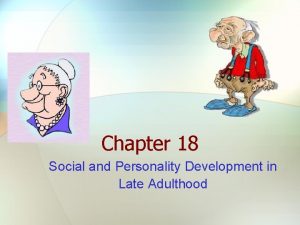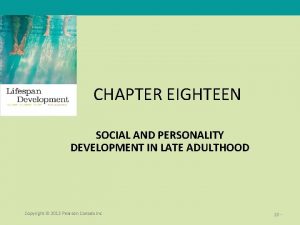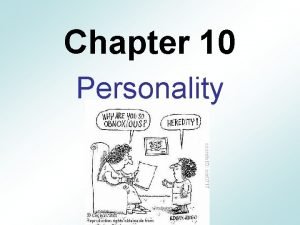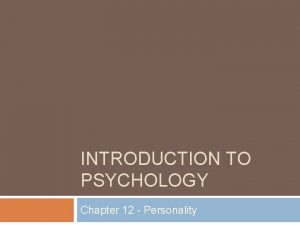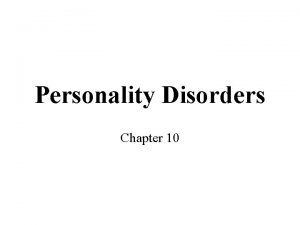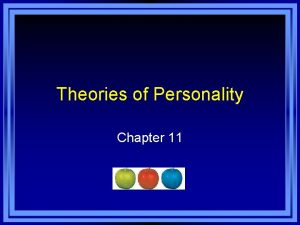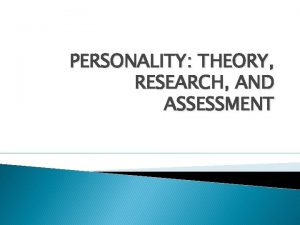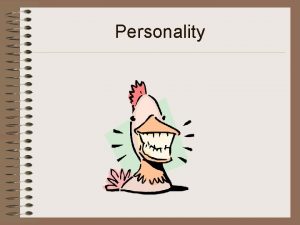CHAPTER 18 SOCIAL AND PERSONALITY DEVELOPMENT IN LATE


































































- Slides: 66

CHAPTER 18 SOCIAL AND PERSONALITY DEVELOPMENT IN LATE ADULTHOOD

PERSONALITY DEVELOPMENT AND SUCCESSFUL AGING

Continuity and Change in Personality • Fundamental continuity to personality • Profound social environmental changes throughout adulthood may produce fluctuations and changes in personality • Some discontinuities in development • What is important to a person at age 80 is not necessarily the same as what was important at age 40.

Discontinuities of Development: What Do Theorists Say? • Changes in personality occur as a result of new challenges in later adulthood. Erikson Robert Peck Daniel Levinson Bernice Neugarten

Erikson Ego-integrity-versus despair • Process of looking back over one's life, evaluating it, and coming to terms with it • Integrity – Comes when people feel they have realized and fulfilled the possibilities that have come their way • Despair – Occurs when people feel dissatisfied with their life, and experience gloom, unhappiness, depression, anger, or the feeling that they have failed

Erikson • Stage begins when the individual experiences a sense of mortality. • This may be in response to retirement, the death of a spouse or close friends, or may simply result from changing social roles. • No matter what the cause, this sense of mortality precipitates the final life crisis. • The final life crisis manifests itself as a review of the individual 1 s life-career. • Individuals review their life-career to determine if it was a success or failure. • Reminiscence or introspection is most productive when experienced with significant others. • Outcome of this life-career reminiscence can be either positive or negative.

Erikson • Ego integrity result of positive resolution of final life crisis • Ego integrity is key to harmonious personality development • the individual views their whole life with satisfaction and contentment. • Ego quality emerging from positive resolution is wisdom. • Erikson defined wisdom as a kind of "informed and detached concern with life itself in the face of death itself" • Conversely, despair is the result of the negative resolution or lack of resolution of the final life crisis. • This negative resolution manifests itself as a fear of death, a sense that life is too short, and depression.

Robert Peck Personality development in elderly people is occupied by three major developmental tasks or challenges • Redefinition of self-versus-preoccupation-with-work-role • Body-transcendence-versus-body-preoccupation • Ego-transcendence-versus-ego-preoccupation

Robert Peck – First Task • First task in old age: redefine themselves in ways that do not relate to their work-roles or occupations. • Must adjust values to place less emphasis on selves as workers or professionals & more on attributes that don't involve work, such as being a grandparent or a gardener.

Robert Peck – Second Task • In second major developmental task in late adulthood, elderly individuals can undergo significant changes in their physical capabilities as a result of aging. • In the body transcendence versus body preoccupation stage, people must learn to cope with and move beyond those physical changes (transcendence).

Robert Peck – Third task • In third developmental task, elderly people must come to grips with: – their coming death – understand that although death is inevitable, and probably not too far off, they have made contributions to society. • If people in late adulthood see these contributions, they will experience ego transcendence. • If not, they may become preoccupied with the question of whether their lives had value and worth to society.

Daniel Levinson People enter late adulthood by passing through transition stage (Although not ‘stages’ I think of them this way) 1. View themselves as being “old” 2. Recognize stereotypes and loss of power and respect 3. Serve as resources to younger individuals 4. Discover new freedom to do things for simple sake of enjoyment and pleasure

Daniel Levinson Stage 1 • People come to view themselves as entering late adulthood—or, ultimately, as being “old. ” Knowing full well what society's stereotypes about elderly individuals are, and how negative they can be, people struggle with the notion that they are now in this category.

Daniel Levinson Stage 2 • According to Levinson, with age people come to realize that they are no longer on the center stage of life, but are increasingly playing bit parts. This loss of power, respect, and authority may be difficult for individuals accustomed to having control in their lives.

Daniel Levinson Stage 3 & 4 • On the other hand, people in late adulthood can serve as resources to younger individuals, and they may find themselves regarded as “venerated elders” whose advice is sought and relied upon. • Old age can bring with it a new freedom to do things for the simple sake of the enjoyment and pleasure they bring, rather than because they are obligations.

Bernice Neugarten 1 & 2 Four different personality types in people in their 70 s • Disintegrated and disorganized • Unable to accept aging • experience despair as they get older. • are often found in nursing homes or are hospitalized. • Passive-dependent personalities • become fearful with age—fear of falling ill, fear of the future, fear of their own inability to cope. • so fearful that they may seek out help from family and care providers, even when they don't need it.

Bernice Neugarten 3 & 4 • Defended personalities • respond to the fear of aging in a quite different manner. They try to stop it in its tracks. • may attempt to act young, exercising vigorously, and engaging in youthful activities. • Unfortunately, they may set up unrealistic expectations for themselves and run the risk of feeling disappointed as a result. • Integrated personalities • most successful individuals cope comfortably with aging. • accept becoming older & maintain a sense of self dignity.

Bernice Neugarten Conclusions • Neugarten found that the majority of the people she studied fell into the final category. They acknowledged aging and were able to look back at their lives and gaze into the future with acceptance.

Life Review and Reminiscence Common Theme of Personality Development • Triggered by increasingly obvious prospect of one's death • Provides better understanding of past • Resolves lingering problems and conflicts • Leads to sense of sharing, mutuality, and feeling of interconnectedness with others

Age Stratification Approaches to Late Adulthood Age stratification • Suggest that economic resources, power, and privilege are distributed unequally at different stages of the life course • Such inequality is particularly pronounced during late adulthood. • Age stratification theories help explain why aging is viewed more positively in less industrialized societies.

What else? • Power and prestige for elderly have eroded in industrialized societies – except for wealthy • Rapidly changing technology causes older adults to be seen as lacking important skills – yet they may not • Older adults are seen as non-productive members of society and in some cases simply irrelevant – by ignorant

Wisdom—expert knowledge in the practical aspects of life— has, until recent years, received little attention from gerontologists and other researchers. Does age bring wisdom?

Developmental Diversity Cultural differences in the way the elderly are treated are often exaggerated • Eskimos do not leave their elderly to die on ice floes • Chinese revere old age but there is great individual variation

Cultures that revere old age have several things in common • Homogeneous in socioeconomic terms • Control of finances by older adults • Continued engagement in socially valued activities • Organized around extended families • Does this apply to families too?

Things to Consider • Wisdom reflects accumulation of knowledge, experience, and contemplation • knowledge that is derived from intelligence is related to the here-and-now • intelligence may permit a person to think logically and systematically • Wisdom is not the same as intelligence • wisdom is a more timeless quality • wisdom provides an understanding of human behavior.

Staudinger and Baltes Study • Older participants benefited more from experimental condition designed to promote wise thinking • Older adults appear to be able to draw on a more sophisticated theory of mind • Other research suggests that very wisest individuals may be older adults.

Successful Aging Secrets: Three major approaches Disengagement theory • Gradual retreat Activity theory • Continued involvement Continuity theory • Compromise position What’s important is maintaining desired level of involvement. • Feeling of control • Empowerment of making own choices

Disengagement Theory: Gradual Retreat • Late adulthood involves gradual withdrawal from world on physical, psychological, and social levels • Withdrawal is a mutual process and not necessarily negative

Activity Theory: Continued Involvement • Happiness and satisfaction from high level of involvement • Adaptation to inevitable changes • Continuing/replacing previous activities

And so… Neither disengagement theory nor activity theory provides a complete picture of successful aging

Continuity Theory: A Compromise Position • People need to maintain their desired level of involvement in society to maximize their sense of wellbeing and self-esteem • Regardless of activity level, most older adults experience positive emotions as frequently as younger individuals • Good physical and mental health is important in determining overall sense of well-being

Selective Optimization with Compensation According to the model proposed by Paul Baltes and Margret Baltes, successful aging occurs when an older adult focuses on his or her most important areas of areas. Is this unique to old age? (Source: Based on Baltes & Baltes, 1990. )

THE DAILY LIFE OF LATE ADULTHOOD

Places and Spaces • Living at Home • Specialized Living Environments – Continuing-care community • Assisted living – Nursing institutions • Adult day care • Skilled nursing

Living in Nursing Homes • Greater the extent of nursing home care = greater adjustment required of residents • Loss of independence brought about by institutional life may lead to difficulties • Elderly people are as susceptible to society's stereotypes about nursing homes

Where do you hope to spend the last days of your life?

I think I can, I think I can…or can I? • Institutionalism and Learned Helplessness • Institutionalism • Learned helplessness

Consequences of Loss of Control in Nursing Home Care • Profound effect on their well-being • Can you think of any of these effects?

Economics of Late Adulthood • People who were well-off in young adulthood remain so in late adulthood • Those who were poor remain poor in late adulthood

Poverty and the Elderly While 10 percent of those 65 years of age and older live in poverty, women are almost twice as likely as men to be living poverty. (Source: U. S. Bureau of the Census, 2005. )

Other Differences Related to Poverty Racial and marital variables • 8 percent of whites in late adulthood live below the poverty level • 19 percent of Hispanics and 24 percent of African Americans live in poverty • Divorced black women aged 65 to 74 had a poverty rate of 47 percent

Financial Vulnerability in Older Adulthood Reliance on a fixed income for support • Social Security benefits • Pensions, and savings, rarely keeps up with inflation Rising cost of health care

Work and Retirement is major decision • Social Security • Part-time employment • Mandatory retirement

Other Questions to Consider • Besides finances, what do you think are some important factors in deciding on the right time to retire? • What factors might contribute to the specific retirement path a given person takes?

Some employers. . • Encourage older workers to leave their jobs in order to replace them with younger employees whose salaries will be considerably lower • Believe older workers are not up to demands of the job or are less willing to adapt to a changing workplace

Retirement decision based on variety of factors Burnout Health concerns Employer incentives Desire to travel, study, or spend more time with family

Atchley & Barusch: Stages Honeymoon period Disenchantment Reorientation Retirement routines Termination

Stages of Retirement

Planning For—and Living—a Good Retirement • • Plan ahead financially Consider tapering off from work gradually Explore interests before retirement If you are married or in a long-term partnership, spend some time discussing views of ideal retirement with partner • Consider where you want to live • Determine advantages and disadvantages of downsizing your current home. • Plan to volunteer your time

RELATIONSHIPS: OLD AND NEW

Marriage in Later Years: Together, Then Alone

Stress of Retirement Stress of retirement or old age may change relationship • 2 percent of divorces in the U. S. involve women over 60 • Husband may be abusive or alcoholic • Husband may find a younger woman Divorce is harder on women than men • 5 percent of the elderly never married and late adulthood brings fewer changes to their lives

Refashioned Relationships For many couples, retirement means that relationships need to be renegotiated • More time together • More sharing in household chores • Role reversals • Health changes

Caring for an Aging Spouse Wide variety of reactions – Positive – Negative • Women more likely to provide care – Men die earlier – Traditional gender role of “caregiver”

Death of Spouse Few events are more painful than death of spouse • No longer part of a couple • Must deal with profound grief • No one to share life with and social life often changes • Economic changes often occur

Process of Adjustment to Widowhood Do you think the process of adjustment is identical for men and women? (Source: Based on Heinemann & Evans, 1990. )

Social Activity in Late Adulthood Friends and family play an important role in the social activities of the elderly.

Why do friends matter? Friendships in late adulthood: • Allow older adults more control about whom to include in a friendship • May be more flexible than family ties • Relate to increasing likelihood, over time, that one will be without marital partner

Social Support Social support is assistance and comfort supplied by another person or a network of caring, interested people • Important for successful aging • Sympathy and empathy • Can help furnish material support such as solve problems, give a ride, or fix broken things • Dogs can be especially good at providing social support

Social Support: Significance of Others Benefits for Recipient • Sympathetic ear and sounding board for one's concerns • Unmatched degree of understanding and a pool of helpful suggestions from like other • Material support Benefits for Provider • Experience feelings of usefulness and heightened self-esteem

Family Relationships: The Ties That Bind Connections important • Siblings, children, grandchildren, and great-grandchildren provide an important source of comfort to adults in last years of their lives – Siblings are important because of shared life – Children often most important

Developmental Stake Parents see their children as perpetuating their beliefs, values, and standards • Most parents and children remain close – 75 percent of children live within a 30 -mile drive to their parents – Daughters tend to be in more frequent contact than sons – Mothers tend to be the recipient of communication more than fathers – Children may turn to their elderly parents for advice, information, and monetary help

Views of Parents and Children Regarding Behavior of Adult Children Toward Parents

Grandparenting Grandparents • Not all grandparents are equally involved with their grandchildren • Gender differences in behaviors and reactions of grandparents and grandchildren • Ethnic differences in grandparenting

When Grandparents Are Great! Great-grandparents • Play less of a role in the lives of both white and African American grandchildren • Close relationships tend to occur only when the greatgrandparents and great-grandchildren live relatively near one another

Elder Abuse Physical or psychological mistreatment or neglect of elderly individuals • May affect as many as 11 percent of elderly • Is most frequently committed by family member • Often result of combination of economic, psychological, and social pressures on caregivers • Best approach for dealing with abuse is prevention
 Social and emotional development in late adulthood
Social and emotional development in late adulthood Middle & late childhood
Middle & late childhood Socioemotional selectivity theory
Socioemotional selectivity theory Emotional development is often stormy and in conflict
Emotional development is often stormy and in conflict Emotional development is often stormy and in conflict
Emotional development is often stormy and in conflict Site:slidetodoc.com
Site:slidetodoc.com Damon's stages of friendship
Damon's stages of friendship Personality development in early adulthood
Personality development in early adulthood Personality development and social etiquette
Personality development and social etiquette Physical development of late childhood
Physical development of late childhood Middle and late childhood
Middle and late childhood Global agenda for social work and social development
Global agenda for social work and social development Psychosocial development in late adulthood
Psychosocial development in late adulthood Ros
Ros Late adulthood mental development
Late adulthood mental development Emotional development for late adulthood
Emotional development for late adulthood Physical development in late adulthood
Physical development in late adulthood Adulthood development stages
Adulthood development stages Emotional development in late adulthood
Emotional development in late adulthood During the late 1800s farmers supported free and unlimited
During the late 1800s farmers supported free and unlimited Social thinking and social influence
Social thinking and social influence Social thinking social influence social relations
Social thinking social influence social relations Lesson 2 the crusades
Lesson 2 the crusades Structure of personality development
Structure of personality development Erikson personality development
Erikson personality development Physical defects in personality development
Physical defects in personality development Infant personality development
Infant personality development Personality development in infancy
Personality development in infancy Summary of personality development
Summary of personality development Determinants of personality development
Determinants of personality development Example of contributor
Example of contributor Conclusion on personality
Conclusion on personality Id ego superego meaning
Id ego superego meaning Contributor identity
Contributor identity Social darwinism vs social gospel answer key
Social darwinism vs social gospel answer key Social cognitive perspective of personality
Social cognitive perspective of personality Social determinants of personality
Social determinants of personality Trait theory
Trait theory Social cognitive personality
Social cognitive personality Personality in greek word
Personality in greek word Social cognitive approaches to personality
Social cognitive approaches to personality Barnum effect
Barnum effect Andrea reger
Andrea reger Social cognitive personality
Social cognitive personality Freud's psychoanalytic theory
Freud's psychoanalytic theory Social cognitive approach
Social cognitive approach Chapter 5 personality and values
Chapter 5 personality and values Objectives of personality
Objectives of personality Chapter 2 personality self-esteem and emotions
Chapter 2 personality self-esteem and emotions The high and late middle ages section 5 quiz
The high and late middle ages section 5 quiz Challenge of middle and late adolescence
Challenge of middle and late adolescence Cross field pits
Cross field pits V
V Immediacy principle linguistics
Immediacy principle linguistics Early and late complications of blood transfusion
Early and late complications of blood transfusion Late design breakage
Late design breakage Early and late complications of blood transfusion
Early and late complications of blood transfusion Proximodistal development
Proximodistal development Industrialists of the late 1800s used pools and trusts to
Industrialists of the late 1800s used pools and trusts to The romantic ideal
The romantic ideal Superlative form de nice
Superlative form de nice Middle and late childhood
Middle and late childhood Histodifferentiation stage of tooth development
Histodifferentiation stage of tooth development Social development in infancy and childhood
Social development in infancy and childhood Personal social examples
Personal social examples Middle childhood emotional development
Middle childhood emotional development Social development in adulthood
Social development in adulthood

